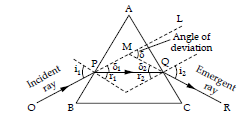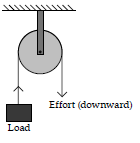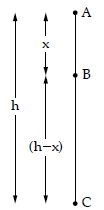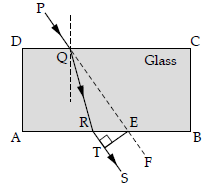Students can refer to the following Sample Paper ICSE Class 10 Physics Set K with Answers provided below based on the latest syllabus and examination guidelines issued for ICSE Physics. All specimen papers have been prepared covering all chapters given in ICSE Physics book for Class 10. You should also refer to ICSE Class 10 Physics Solutions.
Sample Paper ICSE Class 10 Physics Set K with Answers
Class-X
Physics
(Maximum Marks : 80)
(Time allowed : Two hours)
(i) Answers to this Paper must be written on the paper provided separately
(ii) You will not be allowed to write during the first 15 minutes
(iii) This time is to be spent in reading the Question Paper
(iv) The Time given at the head of this Paper is the time allowed for writing the answers
Section I is compulsory. Attempt any four questions from Section II.
The intended marks for questions or parts of questions are given in brackets [].
Sample Paper ICSE Class 10 Physics Set K
SECTION – I
Attempt all questions from this Section.
1. (a) Name a metal commonly used to make a calorimeter. Give a reason to support your answer. [2]
(b) Draw a well labelled circuit diagram for the verification of Ohm’s law. [2]
(c) Why is radioactivity considered to be a nuclear phenomenon? [2]
(d) Draw a ray diagram to show how a convex lens can be used as a magnifying glass. [2]
(e) A metal ball of mass 60 g falls on a concrete floor from a vertical height of 2.8 m and rebounds to a height of 1.3m. Find the change in K.E. in S.I. units. [2]
Sol:-1. (a) Copper. It has low specific heat capacity.
(b)

(c) During radioactivity, the change occurs in the nucleus of the radioactive element. Hence it is considered to be
a nuclear phenomenon.
(d)

(e) Potential energy of ball at height h1 = 2.8 m
P.E1 = mgh1
= 60/1000 × 10 × 2.8 = 1.68 J
∴ Kinetic energy just before striking the ground = K.E1 = 1.68 J …(i)
Potential energy at height h2 = 1.3 m
P.E2 = mgh2
=60/1000× 10 × 1.3 m
= 0.78 J
∴ K.E2 just after rebounding = 0.78 J
∴ Change in K.E. = K.E1 – K.E2
= (1.68-0.78)J
= 0.9 J
2. (a) What is the work done by a force when the force is : [2]
(i) Normal to the displacement produced.
(ii) In the same direction as the displacement produced.
(b) State the S.I. unit of specific heat capacity and heat capacity. [2]
(c) Draw a labelled diagram to show the path of a monochromatic light ray of light in a prism kept at its angle of minimum deviation. [2]
(d) Explain why a single fixed pulley is used despite no gain in mechanical advantage. [2]
(e) A metal wire has a resistance of 60 Ω. It is cut into three equal lengths. Find the equivalent resistance when two parts are connected in parallel and the third part is in series with them. [2]
Sol:-
(a) W = Fd Cos θ
(i) Zero (as F ⊥r d) & Cos 90° = 0
(ii) Work = Force × displacement (as F is parallel to d) and cos 0° = 1
(b) Specific heat capacity = J kg-1 k-1Heat Capacity = Jk-1
(c)

(d) To change the direction of application of effect in a convenient direction.

(e) Resistance of wire = 60 Ω
When cut in three equal parts,
Resistance of each part = 60/3

Resistance between A & C is given by
1/R = 1/20 + 1/20
= 1+1/20=2/20= 1/10
∴ R”=10 Ω
Now resistance between A & B is
R11-10 +20
-3Ω
3. (a) Establish a relation between an electron volt and the S.I. unit of the physical quantity which it measures. [2]
(b) Why is the earth pin of a three-pin plug made longer and thicker? [2]
(c) Write the energy conversions in the following : [2]
(i) Microphone (ii) Lighted candle.
(d) Mention two ways to increase the strength of an electro-magnet. [2]
(e) What characteristics of sound would change if there is a change in its : [2]
(i) Amplitude (ii) Wave form.
Sol.
(a) When an electron is accelerated by a potential of 1 volt, the energy gained by it is termed as electron volt. W – qV
∴ W – 1.6 × 10-19 × 1 Coulomb × volt
∴ 1 eV – 1.6 × 10 -19 Joules
(b) Earth pin is made longer & thicker so that
(i) it must make contact with the circuit before live wire or neutral
(ii) it might not get inserted accidently to line wire.
(c) (i) Sound energy to electrical energy,
(ii) Chemical energy to heat and light energy,
(d) (i) by increasing number of turns,
(ii) by increasing the strength of current,
(e) (i) Loudness,
(ii) Quality or timbre,
4. (a) Which cools faster, Land or Water? Give a reason for your answer. [2]
(b) State any two properties of α radiation. [2]
(c) Scissors for cutting cloth have blades much longer than handles. Why? [2]
(d) Two lamps, one rated 40 W, 220 V and the other having resistance 605 Ω(ohm) 60 W, 220 V are connected in parallel combination across to a 220 V supply. Calculate the current drawn from the supply line. [2]
(e) State two precautions that should be taken while handling radioactive substances.
Sol .
(a) Land: Land has low specific heat capacity than water.
(b) (i) They have high ionizing power and low penetrating power.
(ii) They are positively charge rays and gets affected in electric and magnetic field.
(c) In scissors for cutting clothes, we don’t need gain in torque, rather we need gain in speed. Hence blades are
much longer than handles.
(d) Given,
Lamp – 1 Lamp – 2
P1 – 40 W P2 – 60 W
V – 220 V V – 220 V
I1 = P1/V I2 = P2/V
I1 = 40/220 I2 = 60/220
(Since they are connected in parallel, the voltage drop will be 220 V each)
Total current drawn = I1 + I2
=40/220 + 60/220
=100/220 Ampere
=0.4545 Ampere
(e) (i) One should put on special lead lined aprons and hand gloves.
(ii) One should handle the radioactive materials with long lead tongs.
Sample Paper ICSE Class 10 Physics Set K
SECTION – II
5.(a) Show how the energy of a freely falling object remains conserved. [3]
(b) A uniform metre rod is balanced at the 70 cm mark by suspending a weight of 50 gf at the 40 cm mark and
200 gf at the 95 cm mark. Draw a diagram of the arrangement and calculate the weight of the metre rod. [3]
(c) Draw a diagram of a pulley system of velocity ration 4. Calculate its mechanical advantage if its efficiency is
90%.
Sol.
(a) Consider a body of mass m be dropped from A
Case – 1 (At A)
P.E = mgh
K.E = 0
∴ Total Energy = mgh
Case – 2 (At + B)
Applying v2 = u2 + 2as
Velocity at B can be
obtained as
v2 = (0)2 + 2g x
∴ K.E = ½ mv2
= ½ m ⋅ 2gx
K.E = mg x
P.E = mg (h – x)
T.E. = mg x + mg (h – x)
= mg (x + h – x)
T.E. = mgh
Case – 3 (At C)

Velocity can be obtained as V2 = (0)2 + 2gh
K.E = 1 /2 mv2 = 1/2 m (2gh)
K.E = mgh
P.E = 0
T.E = mgh
From (i), (ii) & (iii) we can conclude that total energy of a freely falling body remains same.
(b)

Let the weight of metre rod be wgf.
Applying principle of moments
Clockwise moment = Anticlock wise moment
200 (95 – 70) = 50(70 – 40) + W(70 – 50)
200 × 25 = 50 × 30 + W × 20
5000 = 1500 + W × 20
= 20 × W = 3500
W =3500/20
W = 175 gf
(c) Given, V.R. = 4
Efficiency η = 90%
∴ Mechanical advantage M.K.
M.A. = η × V.R.
= 90/100 × 4
= 3.6
M.A. = 3.6

6.(a) What is understood by lateral displacement? State two factors on which it depends. [3]
(b) An object is kept at a distance of 15 cm from a convex lens of focal length 10 cm. Calculate the image distance
and state the characteristics of the image formed. [3]
(c) (i) Write two properties common to all the electromagnetic radiations. [4]
(ii) Give one use each of infrared and ultraviolet radiations.
Sol.
(a) L ateral Displacement :
A ray of light while travelling through a rectangular glass slab gets deviated (shifted) from its original path.
This phenomenon is called lateral displacement.

Lateral displacement depends on
(i) Thickness of the glass slab.
(ii) Refractive index of glass slab (or color of light used).
(b) Given u = -15 cm
F = 10 cm
v = ?
Applying, 1/v-1/u
1/v-1/15=1/10
⇒ 1/v=1/10-1/15
1/v=(3-2)/30
1/v=1/30
v=30
Image is formed at a distance of 30 cm on the other side.
Characteristics of image are :
(i) Real
(ii) Inverted
(iii) Magnified
(c) (i) (a) Electromagnetic radiations travel with the speed of light in air/vacuum.
(b) They obey laws of reflection and refraction.
(ii) (a) Infrared radiations are used in night vision cameras.
(b) Ultra violet radiations are used for killing microbes and to sterilize medical instruments.
7. (a) A vibrating tuning fork is placed over the mouth of a burette filled with water. The tap of the burette is opened and the water level gradually starts falling. It is found that the sound from the tuning fork becomes very loud for a particular length of the water column.
(i) Name the phenomenon taking place when this happens.
(ii) Why does the sound become very loud for this length of the water column? [3]
(b) (i) Define power of a lens [3]
(ii) A child is using a spectacle with power of 2.5 D. What is meant by the negative sign?
(iii) Find the focal length of the lens used.
(c) A man standing in front of a wall produces a sound and hears an echo after 3 s. He walks ’X’ m away from the wall and produces the same sound. Now he hears an echo after 5.25 s. Calculate the distance he walked away from the wall. (Speed of sound in air is 340 m/s)
Sol:
(a) (i) Resonance
(ii) At a certain length of water column and hence air column (above water), the frequency of air column and the frequency of tuning fork becomes equal, resonance occurs, amplitude increases hence loud sound is heard.
(b) (i) Power of a lens is defined as the reciprocal of focal length of lens in metres.
Power P =1/f
(ii) Negative sign shows that child is using a concave lens in spectacle that is, the child has short sightedness.
(iii) Focal length=1/P
=1/-2.5meters
=-100/2.5cm
=-40
∴ Focal length of concave lens is 40 cm.
(c) Applying 2d = v × t
2d = 340 × 3
⇒ 2d = 1020 m
Again 2(d + x) = 340 × 5.25
⇒ 2d + 2x = 1785
⇒ 1020 + 2x = 1785
2x = 765
⇒ x = 382.5 m
8. (a) What is an electrical fuse? State two characteristics of an electrical fuse. [3]
(b) What is internal resistance of a cell? Write two factors on which it depends. [3]
(c) In the circuit diagram given below, a cell of 9 V and internal resistance 0.5 (Ω) is connected across a resistor A of 2 Ω in series and two resistors 2 Ω and 6 Ω which are in parallel.

Find :
(i) The total resistance
(ii) The total current
(iii) The current in the 6 Ω resistor
(iv) The potential difference across the terminals of the cell.
Sol:(a) Electrical fuse is a safely device used in the electrical circuits in line wire to prevent excess current entering the circuit thus preventing house hold appliances from damage.
Characteristics of fuse :
(i) It is made up of an alloy of tin & lead having low melting point.
(ii) It has low ohmic loss i.e low resistivity.
(b) Internal resistance of cell is the obstruction offered by the cell to the flow of current through it. Factors on which internal resistance of a cell depends:
(i) Surface area of electrode plates.
(ii) Distance between the electrodes.
(c) (i) Resistance of 2 Ω and 5 Ω resistor connected in parallel is given by
1/r=1/2+1/6=3+1/6=4/6=2/3
r=3/2=1.5Ω
Total resistance = 1.5 + 2 + 0.5= 4 Ω
(ii) Total current = 9/4 = 2.25 Ampere
(iii) Potential drop at 2 Ω and 0.5 Ω is given by
2.25 × 2.5 = 5.625 volts
Potential drop at 2 Ω and 6 Ω (in parallel)
= (9 – 5.625) volts
= 3.375 volts
Current through 6 Ω resistor is given by
I=3.375/6
= 0.5625 Ampere
(iv) Terminal voltage = E – Ir
= 9 – 2.25 × 0.5
= 7.875 volts
9. (a) (i) Define specific latent heat of fusion of ice.
(ii) What happens to the heat supplied to the substance when the heat supplied causes no change in the temperature of the substance? [3]
(b) Two liquids A and B have specific heat capacities 2.5 Jg-1 0C-1 and 3.2 Jg-1 0C respectively. [3]
(i) Which liquid is a good conductor of heat? Why?
(ii) Which liquid is more suitable as a liquid in radiators for cooling? [3]
(c) A calorimeter of mass 60 g contains 180 g of water at 29°C. Find the final temperature of the mixture, when 37.2 g of ice at -10 °C is added to it (specific heat capacity of water = 4200 J/Kg K. latent heat of ice = 336 × 103 J/ Kg. specific heat capacity of ice = 2100 J/Kg K, specific heat capacity of the calorimeter is 0.42 Jg-1 × C-1)
(a) (i) Specific latent heat of fusion of ice is defined as the amount of heat energy required to change the phase of unit mass of ice at 0°C to water at 0°C. Its S.I unit is J/Kg.
(ii) When heat is supplied to a substance and its temperature does not change then heat energy is utilized in changing the phase of that substance either from solid to liquid or liquid to gas. This energy is stored as internal energy of the substance.
(b) (i) Liquid A is a good conductor of heat as it has low specific heat capacity.
(ii) Liquid B is more suitable as a liquid in radiators for cooling as it has high specific heat capacity.
(c) Let the final temperature of the mixture be T°C (Water) Heat given by calorimeter is
60 × 0.42 × (29 – T)
Heat given by water is
180 × 4.2 × (29 – T)
Total heat given = 180 × 4.2 × (29 – T) + 6 × 4.2 × (29 – T)
= 186 × 4.2 × (29 – T)
Heat absorbed by ice is given by
37.2 × 2.1 × 10 + 37.2 × 336 + 37.2 × 4.2 × (T – 0)
= 37.2(21 + 336 + 4.2 T)
According to principle of mixtures
186 × 4.2 × (29 – T) = 37.2 × (357 + 4.2 T]
781.2 × (29 – T) = 37.2 × (357 + 4.2 T)
⇒ 21(29 – T) = 357 + 4.2 T
⇒ 609 – 21 T = 357 + 4.2 T
⇒ 252 = 25.2 T
⇒ T = 10 °C
10. (a) (i) What are back ground radiations?
(ii) Write an equation of an α emission from U92 238
(iii) What will be the change in the rate of radioactivity if the temperature of the radioactive substance is raised to four times the initial temperature? [4]
(b) What is nuclear fusion? Write an equation for it.
(c) (i) Draw a simple labelled diagram of the device you would use to transform 230V AC to 15 V AC.
(ii) What is the name of this device?
(iii) On what principle does the device work?
Sol:(a) (i) Background radiations: There are a number of radioactive isotopes present in the earth’s crust and its surroundings. They keep on emitting radioactive radiations all the time. These radiations are called background radiations

(iii) No change, Radioactivity does not depends on temperature.
(b) Nuclear fusion is a phenomenon in which two smaller nuclei ( at high temperature) combine to form a bigger nuclei liberating a lot of amount of heat energy.

(ii) Step down transformer.
(iii) Electromagnetic Induction.